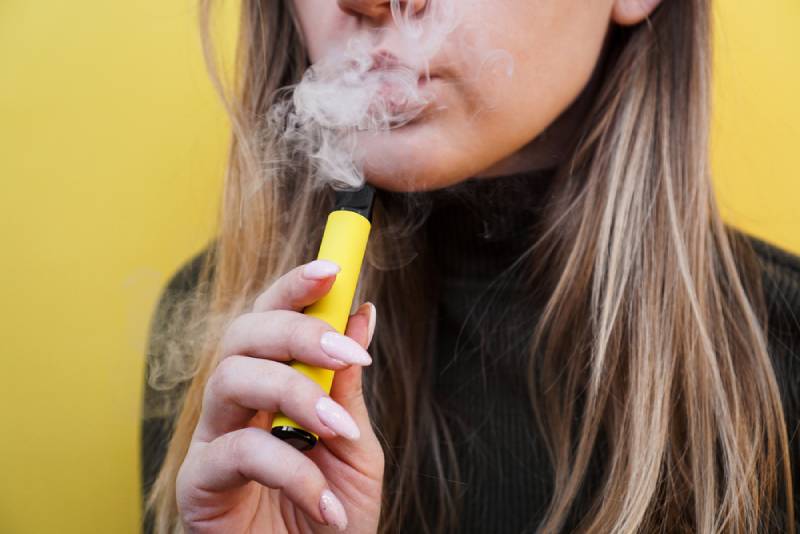
The dangers of secondhand cigarette smoke have been well documented. For example, dogs that are exposed to cigarette smoke regularly are more likely to develop things like eye infections, respiratory issues, allergies, and even cancer than canines that live with non-smoking owners. However, the effects of secondhand vaping haven’t been extensively studied yet. We do know that nicotine, the tobacco-derived chemical that gives cigarettes and vapes their addictive appeal, is extremely toxic to dogs if ingested. The synthetic flavorings in vapes can also be harmful to dogs. To keep your dog safe, avoid vaping indoors, and always store and dispose of cartridges and batteries away from your pets.

Why Dogs and Vapes Don’t Mix
There are a variety of reasons why vapes should be kept away from dogs. The most apparent danger is the chance of accidentally ingesting nicotine, which can be fatal.
Nicotine
Nicotine toxicity is a serious issue for pets. If caught in time, your dog will usually have a good prognosis, but this depends on how much they ingested. Signs of nicotine poisoning include:
These signs may appear as early as 15 minutes after ingestion. However, if you believe your dog has ingested something containing nicotine, you should rush them to the vet immediately. Once your pet starts displaying clinical signs, the poison may have already caused damage to their system.
Aerosol Exposure
The World Health Organization concluded that vapes are considered an air pollutant, which has resulted in a vaping ban in many public areas. Inhaling aerosols is certainly not healthy for dogs but ingesting them can be even worse.
A few years ago many companies switched their antifreeze formulas from ethylene glycol to propylene glycol. Ethylene glycol is highly toxic to humans and animals, and many accidental—and intentional—poisonings have easily occurred because of antifreeze’s sweet taste and lack of odor. While propylene glycol is certainly less toxic, it’s still toxic to pets. You may wonder, why does this matter for vaping? Propylene glycol, the active ingredient in most antifreezes, is the primary agent in e-cigarettes that’s responsible for transforming liquid cartridges into vapors.
Propylene glycol is especially toxic to cats, with no established toxicity threshold for felines. Relatively small amounts can still be fatal in dogs as well. According to the American College of Veterinary Pharmacists, as little as 4 milliliters of propylene glycol can be lethal to a toy breed.
Outside of vapes, propylene glycol is also used as a preservative in many foods. For this reason—and the possibility of many other toxins in human food—it’s always important to check the list of ingredients before giving your dog a human snack.

THC
Some vapes include THC, especially in areas where marijuana is now legal. THC is toxic to dogs, regardless of whether it’s ingested or inhaled. Edibles pose the biggest risk, but secondhand vape can also dangerously expose your dog to THC.
If you believe your dog may have ingested or inhaled something containing THC, or if they show any of these signs, you should take them to the vet immediately. It’s important to let your vet know what’s going on so that they can give them the appropriate treatment quickly by ruling out other possible diagnoses.
Chemical Flavorings
Vapes are available in an endless choice of flavor concoctions. There’s no way to study all of their effects, but we can conclude that at least some of them aren’t safe for dogs to inhale, much less ingest. Air fresheners, cleaning products, and even natural essential oils have long been considered dangerous to dogs. It makes sense that the chemical flavorings found in vapes may pose the same risks.


How to Keep Your Dog Safe If You Vape
You don’t have to give up vaping for your dog’s sake, but you do need to keep their health in mind when choosing where to do it. Avoid vaping indoors or in areas where your dog spends time. This will reduce their risk of inhaling secondhand vapors and reduce the amount of contaminants in the air.
You should also store cartridges and batteries in a closed drawer out of your pup’s reach. Leaving them laying around puts your pet at risk of chewing on the plastic, or accidentally ingesting the vape juice or acid from the batteries. You should also charge your device in a room that your pet can’t access. When the cartridge is empty, make sure to throw it away in a trash can with a secured lid, outside if possible.

Conclusion
Although vapes are touted as safer alternatives to cigarettes, we don’t yet realize the full extent of the negative effects they may have on dogs. Nicotine is currently recognized as the greatest danger, but THC, aerosols such as propylene glycol, and certain chemical flavorings are also toxic to pets. If you vape, be sure to blow off steam away from your pet and store all paraphernalia out of their reach. If you think they’ve accidentally ingested any part of a vape or cartridge, or if they’re showing signs of poisoning, take them to the vet immediately for treatment. Accidents happen, but prompt treatment can save their life.
Featured Image Credit: Dmytro Tyshchenko, Shutterstock
The post Is Vaping Around Dogs Bad? Vet Approved Advice appeared first on Pet Keen.


